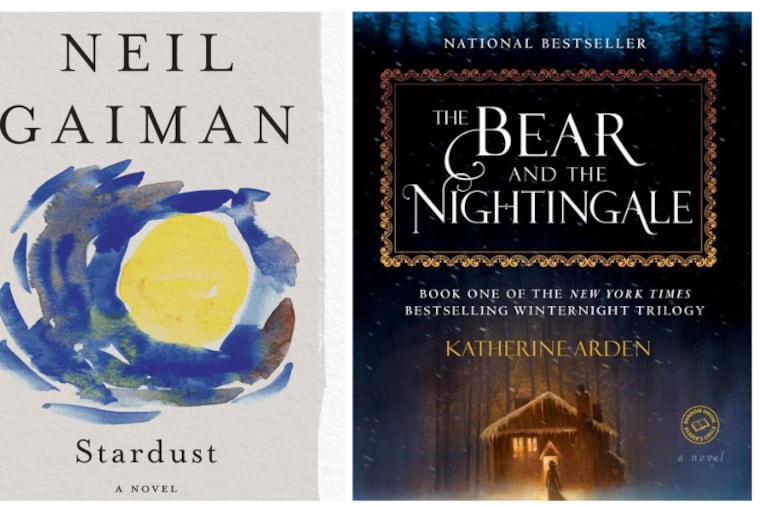The best books to read by the fire: Let’s talk about our favorites in science fiction and fantasy
Feeling nostalgic? Try “The Chronicles of Prydain.” For something more modern, there's “The Midnight Bargain.” And so many more.

Winter is upon us: the nights draw in and we all get to stay indoors ... again. But nothing says books quite like long dark evenings, crackling fires and a mug of hot cocoa. So get warm, curl up and join us on our favorite cozy science-fiction and fantasy reads — and don’t forget to let us know what yours are.
Silvia: For cozy reads, I often go back to my childhood. I loved “The Chronicles of Prydain.” Lloyd Alexander’s series, which begins with “The Book of the Three” (1964), follows Taran, a pig-keeper who becomes embroiled in a series of adventures. He faces off against the evil Arawn and in true quest-fashion, acquires a motley group of friends, including the brave Princess Eilonwy, all against the backdrop of Welsh-inspired mythology.
“Howl’s Moving Castle” (1986) by Diana Wynne Jones has some of those same elements of youthful adventure. Sophie Hatter, who works, as you might imagine, in a hat shop, is magically transformed into an old woman and winds up as a cleaning lady in the employ of a wizard. There are curses to be broken and love to be found. Another novel that strikes a similar note is “Stardust” (1999), Neil Gaiman’s fantasy adventure about a man who pledges to find a shooting star for the beautiful lady he is infatuated with, and journeys from rural England into Fairyland to accomplish his mission.
Lavie: I love the Prydain novels! And since you got me onto childhood fantasy, let me bring up “The Midnight Folk” (1927) by John Masefield, one of the most magical fantasy novels of all time, in which a young orphan, Kay Harker, tries to recover stolen treasure before the local witches get to it. There are no chapters, the magic has the logic of dreams, and while the sequel, “The Box of Delights” (1935), became a British Christmas classic, my heart belongs to “The Midnight Folk.” It came out only a year after another British classic, “Lud-in-the-Mist,” by Hope Mirrlees (an influence on both Neil Gaiman and Susanna Clarke).
I spent October rereading another favorite — Roger Zelazny’s “A Night in the Lonesome October” (1993) — illustrated by the great Gahan Wilson. It’s told from the point of view of a dog, Snuff, whose master, Jack, is one of a group of “openers” and “closers” who gather in a small English village to bring about (or respectively stop) the coming of the Elder Gods. Frankenstein, Dracula, the Wolfman and even a certain Great Detective make appearances, but it’s their animal familiars who steal the show. This final novel by Zelazny, who died in 1995, is also his warmest.
Silvia: For more recent work that evokes thoughts of magic and warmth, I recommend Katherine Arden’s “The Bear and the Nightingale” (2017). It has the vibe of a fairy tale, and the fact that it is set in a cold, wintry land only adds to the desire to cozy up next to a fire to read it. Another newer book is C.L. Polk’s “The Midnight Bargain” (2020), a quasi-Victorian fantasy about a lady with magical powers who hides her abilities but dreams of becoming a sorceress in a world in which women are not allowed this path. The novels I’ve mentioned so far are all bildungsromans, and probably for good reason, as we tend to associate certain narrative forms with youth and therefore with feelings of both joy and nostalgia. But I’ll conclude with something a little different: Helene Wecker’s “The Golem and the Jinni” (2013), which follows two magical creatures as they navigate 19th century New York.
Lavie: If you like nostalgia, W.P. Kinsella’s “Shoeless Joe” (1982) the basis for “Field of Dreams” is hard to beat. It’s the great American baseball fantasy (appropriately enough, written by a Canadian), but at heart it’s about fathers and sons. If you build it, Silvia, he will come! The elusive author featured in the novel is J.D. Salinger, but the film had to change the name to “Terence Mann” for legal reasons, giving the great James Earl Jones another great role to play — not to mention the chance to ghostly vanish into a cornfield with great delight.
As for newer titles, there are plenty of great cozy genre books to choose from: Becky Chambers’s novels, beginning with “The Long Way to a Small, Angry Planet” (2015), Zen Cho’s “Sorcerer to the Crown” duology, Catherynne M. Valente’s “Space Opera” (2018) and Martha Wells’s “Murderbot” series, starting with “All Systems Red” (2017) immediately come to mind. You can’t go wrong with any of them.
Silvia Moreno-Garcia’s books include “Mexican Gothic,” “Velvet Was the Night” and “The Return of the Sorceress.” Lavie Tidhar’s most recent novels are “The Escapement” and “The Hood.”